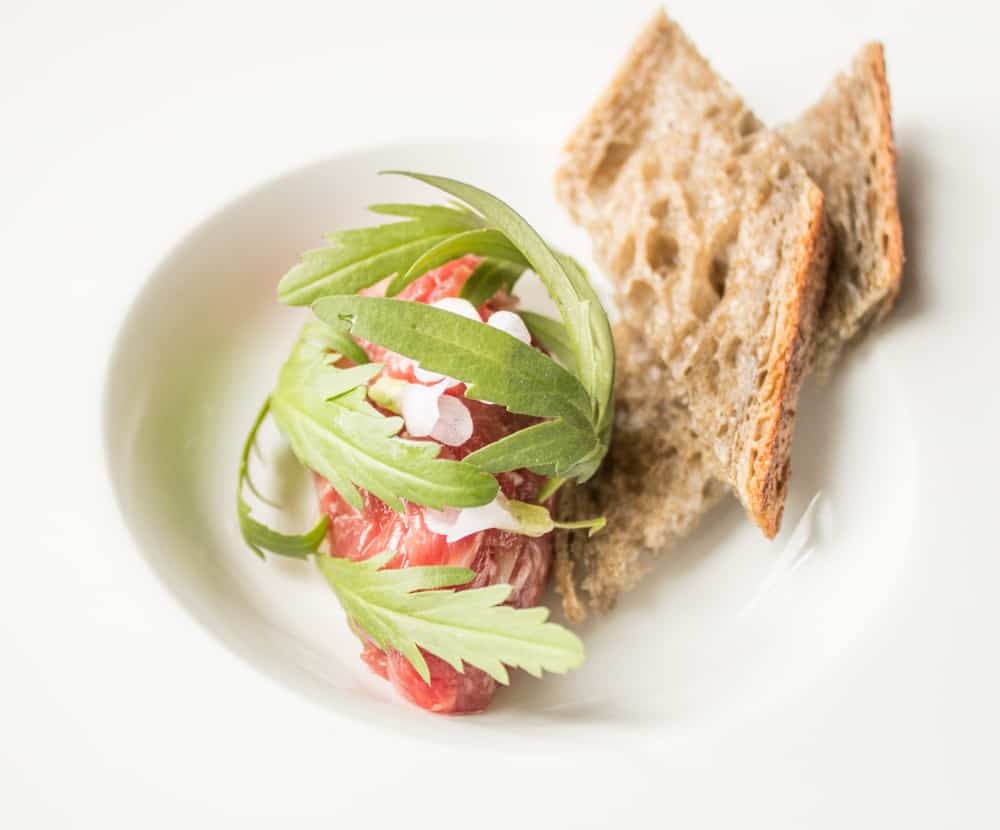Cut leaved toothwort is an edible spring plant foragers should know. There’s a number of toothworts, but for this post I’m only referring mostly to Cardamine concatenata. Dentaria laciniata, Cardamine laciniata and Cardamine dentata are synonyms.

The plant is native to North America. Like some other edibles that enjoy the same habitat (hardwood forests with rich, moist soil, often growing near ramps, trout lily, and spring beauty), toothwort is an ephemeral spring wildflower.


That means it comes up early in the spring and goes to flower and seed quickly to take advantage of the lack of deciduous tree cover and the early sunshine. It does well in part shade and is a great addition to woodland gardens.

Harvesting
When I harvest toothwort for the table, I use a scissors to clip the greens, then I put them in a paper bag or other container and bring them home as quickly as I’m able.

Once the greens are back in the kitchen they may have wilted, so I soak them in a sink of cold water for 30 minutes or so to refresh them, after which they’ll be as good as new. From there I store them in zip loc bags in the fridge, where they can last for up to a week if needed, although I typically eat them within a day or two.

How to Use Toothwort
Cutleaf toothwort is in the Brassicaceae, meaning that it’s related to plants like turnips, broccoli and mustard greens, and more importantly, horseradish. When you taste one of the leaves, what you will taste is a spicy, mustardy flavor of horseradish.
Confusingly, the strong taste of the leaves doesn’t add up to how they taste on the palate, seasoned and combined with other greens in a salad.

Combined with other ingredients, or even simply seasoned with olive oil and lemon juice, the flavor of toothwort becomes a little more submissive. Mixed with a few other greens it can make a nice, mustardy addition.
You'll still taste a bitter punch here and there, but it's a good bitter, not like garlic mustard or yellow rocket which I see as mediocre edibles.

This is a good thing if you don’t want to blow people away with the flavor of horseradish. Just think of it as a mild, tasty green that would like to be in a salad.
You can also cook it, preferably with other greens in a blend, but it’s structure and form is light weight and diminutive, so expect it to fade into the background.

During the beginning of spring, Cutleaf toothwort is a very small sprout of a green, easy to overlook. As it grows and prepares to flower, the plants will get larger, with some specimens I’ve seen pushing 6 inches across. The plant is fine to eat in all the stages of growth, but might get a bit unwieldy tossed into a salad at the end of spring.

Toothwort Rhizomes (Tubers)
The above-ground, leafy green flowering portion of the plant is what I typically harvest, but there are also small tubers or rhizome segments under the ground that pack a strong horseradish flavor. Another name for them is pepper root.

Personally, I don’t see the point in harvesting the tubers of D. laciniata as it requires digging in the soil and removing the tubers that will kill the plants, and, the tubers size makes it seem hardly worthwhile to me when there are so many other leafy greens and abundant foods available in spring time.
That said, the rhizomes of Broadleaf toothwort (Cardamine diphylla) are much larger than the others. They can be harvested, scrubbed clean, and pureed with vinegar to make a horseradish substitute that's quite good.
To make toothwort horseradish, mix 8 oz of chopped rhizomes with ½ cup rice wine vinegar, 1 tablespoon sugar and 1 teaspoon salt. Blend in a highspeed blender until finely ground, then store in the fridge.
Eating
Toothwort doesn't need a lot done to it to be useful, just the opposite, less is more here. To enjoy it in a salad, I recommend starting out mixing it in proportions of roughly 25-50% of the total weight of greens for a salad.
Season the salad with good extra virgin olive oil or another delicious oil you like such as Sam Thayer's hickory nut or acorn oil. Season the greens with salt and pepper, a dash of vinegar or lemon juice, mix, taste the seasoning and adjust for salt and acid until it tastes good to you, and serve.
Spring Ephemeral Salad
Equipment
- 1 Scissors
- 1 mixing bowl
Ingredients
- 8 oz fresh spring ephemeral greens leaves, stems and flowers
- kosher salt and fresh ground black pepper
- Fresh lemon juice or a dash of vinegar--your choice
- Good tasting salad oil like extra virgin or a rich nut oil
- Fresh herbs, to taste like torn mint or basil leaves
Instructions
- Wash the greens well in cold water, then dry completely in a salad spinner or by gently wrapping in towels.
- Toss the greens with a touch of oil, salt, pepper and herbs, then acid to taste, and serve.


Jay
Please note that depending on your location, the population of this species ranges from critically imperilled to secure. Sometimes it’s best to enjoy where they are:)
There’s a good range & conservation status map on this website:
https://ozarkedgewildflowers.com/spring-wildflowers/cutleaf-toothwort-cardamine-concatenata/
Alan Bergo
Sure, I can't cover every area here. Where I live it's extremely common. I'll add that harvesting the above ground portion of the plant is the only thing I do, and the plants will return every year.